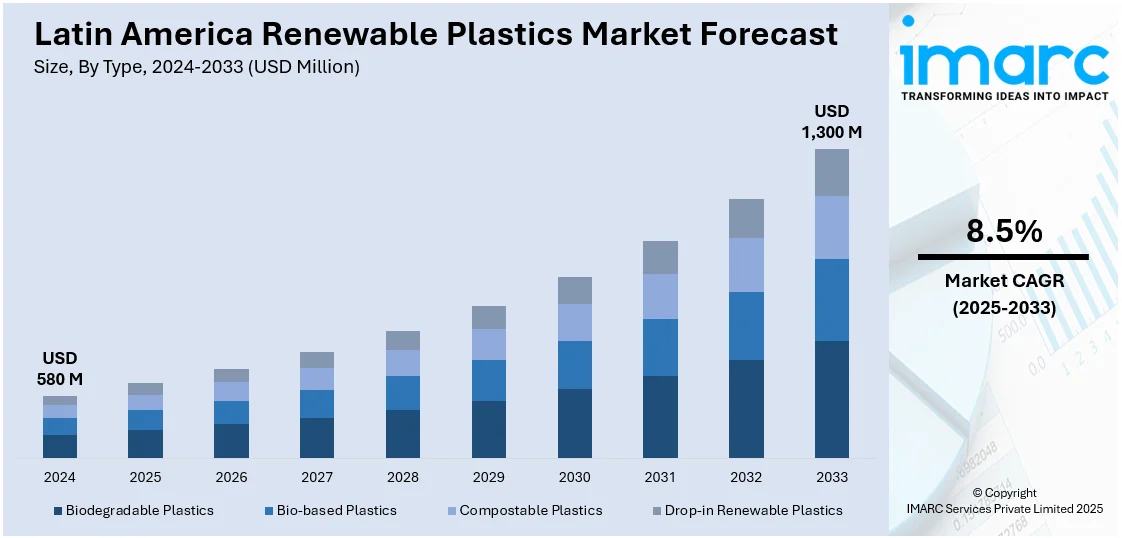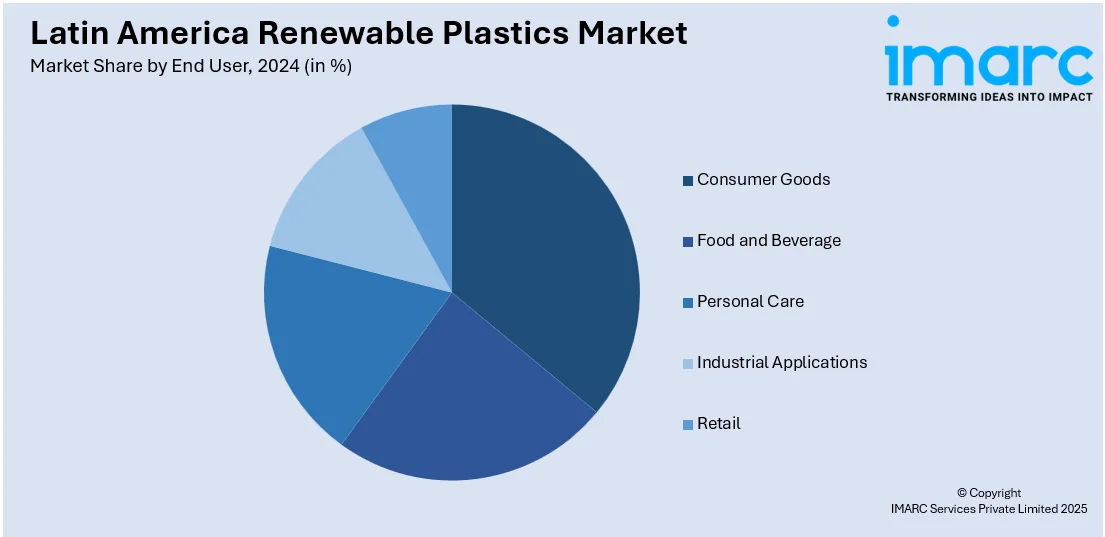
Latin America Renewable Plastics Market Size, Share, Trends and Forecast by Type, Source Material, Product Form, End User, and Country, 2025-2033
Latin America Renewable Plastics Market Overview:
The Latin America renewable plastics market size reached USD 580 Million in 2024. Looking forward, IMARC Group expects the market to reach USD 1,300 Million by 2033, exhibiting a growth rate (CAGR) of 8.5% during 2025-2033. The market is expanding, driven by the demand for sustainable packaging and government support for circular economies. Moreover, recycling technology, bio-based materials, and collaborations for sustainable manufacturing are driving expansion, thereby minimizing fossil fuel dependency and helping achieve climate objectives.
|
Report Attribute
|
Key Statistics
|
|---|---|
|
Base Year
|
2024
|
|
Forecast Years
|
2025-2033
|
|
Historical Years
|
2019-2024
|
| Market Size in 2024 | USD 580 Million |
| Market Forecast in 2033 | USD 1,300 Million |
| Market Growth Rate 2025-2033 | 8.5% |
Latin America Renewable Plastics Market Trends:
Expanding Investment in Sustainable Solutions
The Latin American renewable plastics sector is experiencing remarkable investments as enterprises and governments target green manufacturing. The move away from plastic waste and towards sustainable material utilization is the core concentration. Moreover, companies are making investments in state-of-the-art recycling machinery, ramping up bio-based polymer output, and driving circular economy projects. The move follows increasing consumer sentiment and stricter lawmaking regarding disposable plastics, challenging firms to manufacture more sustainable counterparts. In March 2025, Brazil’s plastics industry announced plans to invest USD 1.8 Billion annually in sustainable packaging, recycling advancements, and improved reverse logistics. Despite global trade uncertainties and tariff threats, the sector remains committed to driving sustainable growth. Besides, firms are teaming up with technology companies to improve material recycling processes, developing high-quality recycled resins used in numerous applications. The investments will significantly mitigate plastic waste, enhance domestic value chains, and boost the adoption of renewable plastics in industries such as consumer products and automobiles. With the assistance of government support and private investment, Latin America is becoming a hub for renewable plastics innovation that will help curtail carbon emissions and usher in a greener future.

Strategic Partnerships for Renewable Polymers
Collaborations and strategic alliances are becoming key drivers of the renewable plastics market in Latin America. Companies are forming partnerships to scale up the production of bio-based and recycled plastics, advancing the circular economy. These collaborations foster technological innovation, accelerate sustainable product development, and expand market reach. In October 2024, Neste and Braskem entered an agreement to supply renewable and recycled feedstocks for polymers and chemical production in South America. Using Neste RE, a sustainable feedstock derived from plastic waste and renewable materials like used cooking oil, Braskem integrated bio-circular polymers into its Wenew product line. This move aimed to reduce dependence on fossil fuels and contribute to carbon neutrality goals. The adoption of chemically recycled and bio-based polymers has facilitated the production of eco-friendly packaging, consumer products, and industrial materials. Moreover, partnerships like these have encouraged companies to adopt International Sustainability and Carbon Certification (ISCC) standards, ensuring traceability and sustainability across the supply chain. By supporting large-scale renewable plastics production, these alliances are contributing to resource conservation, reducing emissions, and driving the region’s transition towards a sustainable economy.
Latin America Renewable Plastics Market Segmentation:
IMARC Group provides an analysis of the key trends in each segment of the market, along with forecasts at the region/country level for 2025-2033. Our report has categorized the market based on type, source material, product form, and end user.
Type Insights:
- Biodegradable Plastics
- Bio-based Plastics
- Compostable Plastics
- Drop-in Renewable Plastics
The report has provided a detailed breakup and analysis of the market based on the type. This includes biodegradable plastics, bio-based plastics, compostable plastics, and drop-in renewable plastics.
Source Material Insights:
- Plant-based Sources
- Animal-based Sources
- Synthetic Biopolymers
- Waste Materials
- Post-Consumer
- Agricultural Residue
A detailed breakup and analysis of the market based on the source material have also been provided in the report. This includes plant-based sources, animal-based sources, synthetic biopolymers, and waste materials (post-consumer and agricultural residue).
Product Form Insights:
- Films
- Sheets
- Foams
- Fibers
- Resins
A detailed breakup and analysis of the market based on the product form have also been provided in the report. This includes films, sheets, foams, fibers, and resins.
End User Insights:

- Consumer Goods
- Food and Beverage
- Personal Care
- Industrial Applications
- Retail
A detailed breakup and analysis of the market based on the end user have also been provided in the report. This includes consumer goods, food and beverage, personal care, industrial applications, retail.
Country Insights:
- Brazil
- Mexico
- Argentina
- Colombia
- Chile
- Peru
- Others
The report has also provided a comprehensive analysis of all the major country markets, which include Brazil, Mexico, Argentina, Colombia, Chile, Peru, and others.
Competitive Landscape:
The market research report has also provided a comprehensive analysis of the competitive landscape. Competitive analysis such as market structure, key player positioning, top winning strategies, competitive dashboard, and company evaluation quadrant has been covered in the report. Also, detailed profiles of all major companies have been provided.
Latin America Renewable Plastics Market News:
- March 2025: Brazil’s plastics industry announced investments of USD 1.8 Billion annually to advance sustainable packaging, recycling technologies, and reverse logistics. Despite global uncertainties and tariff threats, these initiatives supported renewable plastics development, enhanced circular economy efforts, and strengthened the country's petrochemical sector
- October 2024: Neste and Braskem partnered to supply renewable and recycled feedstocks for polymers and chemicals production in South America. By reducing fossil feedstock reliance, the initiative supported circular economy goals, enhanced sustainable production, and contributed to the growth of the renewable plastics sector.
Latin America Renewable Plastics Market Report Coverage:
| Report Features | Details |
|---|---|
| Base Year of the Analysis | 2024 |
| Historical Period | 2019-2024 |
| Forecast Period | 2025-2033 |
| Units | Million USD |
| Scope of the Report |
Exploration of Historical Trends and Market Outlook, Industry Catalysts and Challenges, Segment-Wise Historical and Future Market Assessment:
|
| Type Covered | Biodegradable Plastics, Bio-based Plastics, Compostable Plastics, Drop-in Renewable Plastics |
| Source Materials Covered |
|
| Product Forms Covered | Films, Sheets, Foams, Fibers, Resins |
| End Users Covered | Consumer Goods, Food and Beverage, Personal Care, Industrial Applications, Retail |
| Countries Covered | Brazil, Mexico, Argentina, Colombia, Chile, Peru, Others |
| Customization Scope | 10% Free Customization |
| Post-Sale Analyst Support | 10-12 Weeks |
| Delivery Format | PDF and Excel through Email (We can also provide the editable version of the report in PPT/Word format on special request) |
Key Questions Answered in This Report:
- How has the Latin America renewable plastics market performed so far and how will it perform in the coming years?
- What is the breakup of the Latin America renewable plastics market on the basis of type?
- What is the breakup of the Latin America renewable plastics market on the basis of source material?
- What is the breakup of the Latin America renewable plastics market on the basis of product form?
- What is the breakup of the Latin America renewable plastics market on the basis of end user?
- What are the various stages in the value chain of the Latin America renewable plastics market?
- What are the key driving factors and challenges in the Latin America renewable plastics?
- What is the structure of the Latin America renewable plastics market and who are the key players?
- What is the degree of competition in the Latin America renewable plastics market?
Key Benefits for Stakeholders:
- IMARC’s industry report offers a comprehensive quantitative analysis of various market segments, historical and current market trends, market forecasts, and dynamics of the Latin America renewable plastics market from 2019-2033.
- The research report provides the latest information on the market drivers, challenges, and opportunities in the Latin America renewable plastics market.
- Porter's five forces analysis assist stakeholders in assessing the impact of new entrants, competitive rivalry, supplier power, buyer power, and the threat of substitution. It helps stakeholders to analyze the level of competition within the Latin America renewable plastics industry and its attractiveness.
- Competitive landscape allows stakeholders to understand their competitive environment and provides an insight into the current positions of key players in the market.
Need more help?
- Speak to our experienced analysts for insights on the current market scenarios.
- Include additional segments and countries to customize the report as per your requirement.
- Gain an unparalleled competitive advantage in your domain by understanding how to utilize the report and positively impacting your operations and revenue.
- For further assistance, please connect with our analysts.
 Request Customization
Request Customization
 Speak to an Analyst
Speak to an Analyst
 Request Brochure
Request Brochure
 Inquire Before Buying
Inquire Before Buying




.webp)




.webp)












